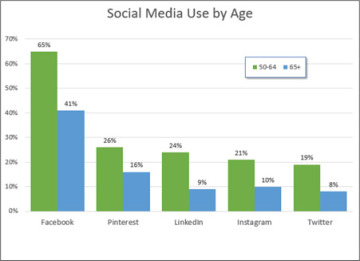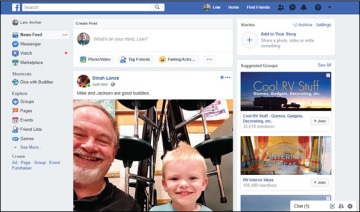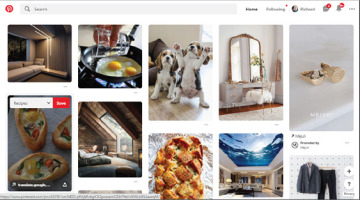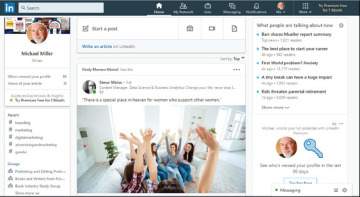- Examining Different Types of Social Media
- Discovering the Top Social Media
Discovering the Top Social Media
Of all the various social media available today, which should you be interested in? The answer, as you might suspect, is that it all depends.
You need to choose your social media based on what you’re interested in and who you want to stay in touch with. For example, if you just want to stay in touch with your cousin Emily and her family, or the neighbors from your old neighborhood, or the folks you go to church with, then a general social network such as Facebook is the right choice. If, on the other hand, you want to keep in contact with your old business associates, then LinkedIn’s professional networking makes more sense. If you like to share pictures of recipes and do-it-yourself (DIY) projects, consider Pinterest. Or if you want to stay hip with what your younger children or grandchildren are up to, then the youth-oriented Twitter is the place to be.
That said, some social media have more appeal to older users than do others. The following graphic details the percentage of online users aged 50 and up who use various social media.
As you can see, Facebook is definitely the big dog among more mature users. If you use only one social medium, that’s the one. But Pinterest and LinkedIn—and even Instagram and Twitter—also have appeal and might be worth considering. Let’s take quick look at what each of these social media have to offer.
There are lots of reasons why Facebook (www.facebook.com) is used by the majority of online users over 50. It’s big (more than 2.3 billion users each month), which means that most of your friends and family are already using it, so there are lots of people to interact with. It offers a variety of features that help you connect or reconnect with people you know or used to know. And it’s easy to use and doesn’t require a lot of technical or computer expertise. In short, it’s the whole ball of wax in a very user-friendly package.
People use Facebook to keep their friends informed of their latest activities, as well as to keep in touch with what their friends are doing. The average adult Facebook user has more than 300 friends on the site and spends more than 35 minutes every day connected to the Facebook site.
Because of its general nature, Facebook is popular among people of all ages. Users range from grade schoolers (actually, the official minimum user age is 13) to retired snowbirds—with the older generation making up most of the site’s growth in recent years.
In addition to posting and reading status updates, Facebook users have access to a variety of other community features. Facebook offers topic-oriented groups, pages for companies and celebrities, photo and video sharing, social games, instant text messages, one-to-one video chats, and even live video broadcasting. Many people log onto Facebook in the morning and stay logged in all day—there’s that much to do there. And you can access all of Facebook’s features from your computer, smartphone, or tablet.
In short, Facebook is the premier social medium for online users of all ages—and especially for those over age 50.
Pinterest (www.pinterest.com) has risen to become the number-two social medium among older users, used by more than a quarter of those aged 50 to 64. In a way, Pinterest is like Facebook but with only pictures. Members use Pinterest to share photos and other images they find interesting with their family and online friends.
The way it works is you find an image from a website or another user, and then you “pin” that image to one of your personal boards on the Pinterest site. Other users see what you’ve pinned, and if they like it, they repin it to their boards.
A Pinterest board is like an old-fashioned corkboard, only online. Your boards become places where you can create and share collections of those things you like or find interesting. You can have as many boards as you want, organized by category or topic. It’s a way to collect images you like and share them with the wider Pinterest community.
Pinterest is unique among today’s social media in that it has been strongly embraced by women of all ages. More than 80% of Pinterest users are women, and half are over age 40. Pinterest users are more likely to live in Midwestern states instead of the coasts, and two-thirds are firmly middle-class.
The visual nature of Pinterest makes it attractive to non-technical users. It’s the number-two social medium for older users, closely behind LinkedIn. If you’re into collecting or recipes or DIY projects, Pinterest has a lot to offer.
LinkedIn (www.linkedin.com) is a social network, like Facebook, but with a distinct focus on business. The site was launched in 2003 and currently has more than 500 million registered users. LinkedIn is the number-three social medium among users 50 to 64—and number-four among those 65 and older.
LinkedIn is used primarily by current and former business professionals for networking and job hunting. It’s a great place to keep in touch with current and former co-workers, as well as others in your profession.
About a third of LinkedIn users are at least 50 years old. That’s more than 150 million users aged 50 or older. Because of its professional focus, LinkedIn has a higher percentage of higher-income users than any other social media. Most LinkedIn users are successful in their chosen professions, with close to half describing themselves as “decision-makers” in their companies.
In addition, millions of companies have LinkedIn Pages to establish a strong industry presence. LinkedIn also counts among its members executives from all Fortune 500 companies.
People use LinkedIn to expand their list of business contacts, keep in touch with colleagues, give and receive professional endorsements, and keep abreast of developments in their professions. Contacts made on LinkedIn can be used for a number of different purposes, such as finding employment, making a sale, or exploring business opportunities. You also can use LinkedIn to gain an introduction to a specific individual you’d like to know, via connections with mutual contacts.
In short, if you’re a business professional, LinkedIn needs to be part of your social media portfolio. Compared to other social media, the overall tone and demeanor of this one is serious.
Twitter (www.twitter.com) is a microblogging service popular with people in their 20s and 30s and with those who like to follow celebrities and politicians. Users post relatively short (280-character) text messages, called tweets, from their computers or mobile phones; a tweet also can include a web link, picture, or video. Tweets are displayed to a user’s followers and are searchable via the Twitter app or website.
Although Twitter gets a lot of media attention, it comes in as the fifth most-used social network for users of all ages, including those aged 50 to 64. Twitter currently has more than 300 million users each month who generate more than 500 million tweets each day. Only about a quarter of Twitter’s users are older than age 50, however; perhaps because it’s a bit more technically difficult to use, Twitter remains a social medium targeted at younger users.
Unlike Facebook, Twitter has few community-oriented features, which has also hindered the service’s mainstream acceptance. Twitter is a microblogging service, not a full-featured social network. With Twitter, you only get message posting and following; there’s no photo sharing or groups.
Given Twitter’s limitations, why do younger people like it so much? Like Facebook, some people use Twitter to inform friends and family of what they’re doing and thinking. Others use Twitter as a kind of personal blog, posting random thoughts and comments for all to read. Businesses use Twitter to promote their brands and products, making announcements via their Twitter feeds. Celebrities and entertainers (arguably the most-followed tweeters) use their Twitter feeds as a kind of public relations (PR) channel, feeding information of their comings and goings to their fan bases. As you’ve probably noticed, politicians (and presidents) also use Twitter to get their messages out to the faithful. And news organizations use Twitter to dissect the tweets of the rich and famous and disseminate the latest news headlines.
That last bit is important. Although Twitter is not a formal news medium, in that it has no central organization or paid reporters, it has become an important medium for disseminating breaking news stories. Today, many major news stories are tweeted before they’re announced by the traditional news media, either by individuals on the scene or by reporters who can quickly tweet about an event before filing a lengthier news report.
So if you want to keep abreast of breaking news (both actual and celebrity-related), follow the pontification (or ravings) of your favorite politician, or just want to see what the younger generation is up to, give Twitter a spin. Otherwise, a more full-featured social network, such as Facebook, is probably a better choice.

Instagram (www.instagram.com) is the fourth most popular social medium among users aged 50 to 64. Unlike the other social media discussed here, Instagram is primarily mobile-based; it’s essentially a media sharing network based on a mobile app for Apple and Android phones and tablets. You use the Instagram app to take pictures and videos with the camera in your phone or tablet, and then you post those items to the Instagram network. The pictures and videos you post are viewed by your friends and followers and then shared with their friends and followers.
Although Instagram has a website, it’s really mobile-based, as it relies on the pictures and videos you take with your smartphone. In fact, some people use the Instagram app solely for taking pictures, as it offers a variety of filters and special effects to enhance the photos you take.
People use Instagram to visually document their lives. When you do something of interest, you snap a picture and post it to Instagram. Your friends do the same. You don’t need to read long, boring text posts—just look at pictures. There’s an appeal to that—especially among younger users. To that end, 71% of Instagram’s 1 billion or so users are aged 34 or younger; only 5% of all users are aged 55 and up.
Instagram’s users are quite active, posting more than 100 million photos and videos each day. That makes Instagram one of the top photo-sharing services on the Internet—even without the social component.






